Endowed with 63 caves, 61 of which remain unexplored, a Davao del Sur town catches the attention of tourists and spelunkers


Endowed with 63 caves, 61 of which remain unexplored, a Davao del Sur town catches the attention of tourists and spelunkers


EARTH’S crevices have their own way of greeting visitors. Some are plain holes at the side of the hills or mountains, others are like remnants of unplanned diggings on plain surfaces covered by tall and unkempt grasses.
In this interior village far from the población of Matanao, Davao del Sur, the Su’bon Cave looks like a gaping mouth of an ancient Tyrannosaurus rex, with fangs still ready to devour the adventurous spelunkers.
A lone white-barked tree rises in splendor atop the cave’s entrance, but its roots grip through the entire outside passage like an immotile creature unwilling to part with its bosom to cling for life. A creek flows endlessly from its mouth, indicating the cave’s origin as a waterway weaving from some hole aboveground and creating a deep crevice that the Blaan tribe described as a hole emitting an unpleasant odor, hence the name Su’bon.
“Our tribespeople speak of this cave with a bad impression
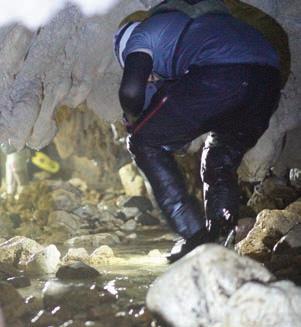
of its smell,” Mylene Fernandez, a Blaan tribal cave guide, told the BusinessMirror during a municipality-sponsored guided tour to one of the 63 caves of the town, of which only two have been officially designated as safe and legally allowed to

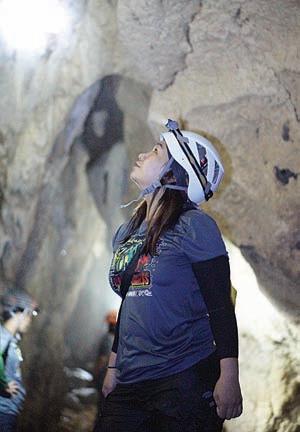
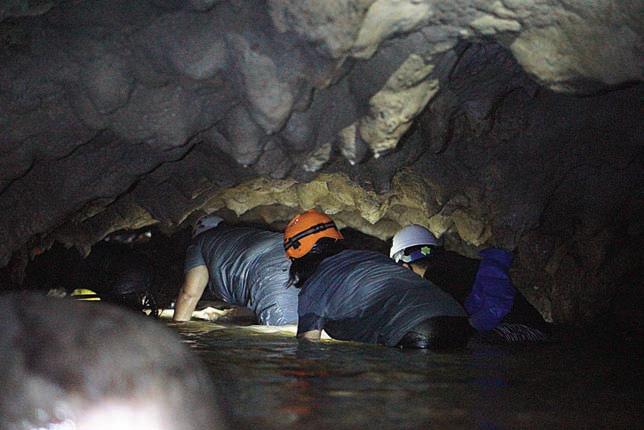

be opened for spelunkers.
In the distant past, what once emitted an unpleasant odor now unveils a breathtaking natural wonder—a magnificent architectural masterpiece supported and embellished by an array of both
miniature and massive stalactite columns meeting their stalagmite counterparts. Together, they create pillars reaching heights equivalent to a four-story building. At some point of the 250-meter length of winding trail, explor -
ers and visitors would be forced to crawl on all fours for about 20 meters, with only less than two feet of breathing space between the cave’s array of stalactites and flowing cool waters of the cave.
Next, another cave welcomes
you with an expansive chamber soaring up to 50 meters in height, marked by the presence of two or three winding tunnels branching out like dampened whirlpools.
Festival
THE province of Davao del Sur has been anchoring its tourism blitz on its blessed location at the southern foothills of Mount Apo, the country’s highest peak at 10,313.6483 feet or 3,143.6 meters. Besides towering majestically above all other mountains in the country, this dormant volcano is famous for its being home to the rare and endangered Philippine Eagle (Pithecophaga jefferyi), the rare Waling-Waling orchid, and a host of other endemic and critically endangered flora and fauna.
C lover Jane C. Sabornido, tourism officer of the municipality of Matanao (this place is called Matan-ao by the local inhabitants and the surrounding provinces), said the municipal government has also devised plans to take a chip off of the provincial push for tourism attraction.
“

We were thinking of what else should we do to partake of the blessings of the province’s tourism promotion. We agree that we have these caves, all 63 of them in one town, and we find it our unique feature to capture the interest of tourists and to contribute to the total allure of the province,” she told a group of online video bloggers and journalists on September 6. A cave congress was the central event, with spelunking taking the spotlight as the pinnacle activity.
Th is town is 92 kilometers southwest of Davao City and the caves are some 20 kilometers to the west of población Matanao.
In nature’s belly
THE Su’bon Cave is one of the first batches of caves, along with Asbang Cave, to come out of the evaluation by the Department of En-
Instead, the Europeans found President Xi Jinping’s government looking to talk, make promises and avoid aggressive rhetoric that could inflame an economic relationship worth $900 billion. While Vice Premier He Lifeng expressed “concern and dissatisfaction” over the probe, he agreed to set up several working groups, including on financial services and trade curbs.
Flipside
BEIJING’S careful managing of its ties with a top trading partner comes amid a broader push to stabilize relationships, as the world’s second-largest economy loses steam, deflating expectations it will overtake the US as No. 1. The economic slowdown and Covid-19 restrictions combined with persistent tensions with the West sparked a $188-billion exodus from Chinese stocks and bonds from a December 2021 peak through the end of this June.
C hina has hosted four Cabinet-level White House officials in
Beijing in recent months, and reestablished working groups with the US ahead of a potential Xi meeting with President Joe Biden in November. The Chinese leader on Tuesday pledged to promote “stable” relations with Italy, even as the nation plans to exit his signature Belt and Road Initiative.
Australian Prime Minister Anthony Albanese, meanwhile, is likely to come to China soon in a sign of how much ties have improved from a nadir in 2020. At that time, both sides were highly critical of each other and China was tariffing and blocking Australian exports.
Beijing is aware that it’s in desperate need of repairing its ties with the EU,” said Alicja Bachulska, policy fellow at European Council on Foreign Relations’ Asia Programme, citing the Asian nation’s “increasingly protectionist and security-focused” economic policies. “That is why its rhetoric was relatively mild.”
W hen Europe announced the probe into subsidies for EVs earlier
this month, Beijing initially blasted that move a “naked act of protectionism.” That sparked concerns in Europe that China had over-reacted and could trigger a trade war, according to European officials who asked not to be named.
C hina didn’t publicly repeat that criticism during Valdis Dombrovskis’ four-day trip to the country. Instead, he was the one who delivered the strongest language—blasting China’s stance on the war in Ukraine as a liability for its image as a good investment destination, and threatening to be
more “assertive” about rectifying a yawning trade imbalance.
Dombrovskis had reason to feel confident. Xi has struggled for years to find a response to US sanctions, tariffs and export controls that makes his nation look tough without scaring off foreign companies. Beijing responded to then-US President Donald Trump’s trade curbs with its own “unreliable entities” list, but only used the tool for the first time in February this year—on two US defense firms with limited business in China.
In July, Beijing imposed export restrictions on two niche metals, gallium and germanium, that are critical for electric cars and chips, in its most meaningful retaliation to US and European trade curbs. That sparked concerns about shortterm disruptions to supply chains, and fears that a more serious trade war with Beijing could undermine
the EU’s green ambitions.
‘Promise fatigue’
THE Chinese Commerce Ministry in Beijing, however, this month said it had already approved some companies to ship those products overseas. That came after reports China’s exports of the metals had plunged, at a moment where the economy is being hurt by slowing demand for its overseas shipments.
Any retaliation to Europe could undermine the Communist Party’s charm offensive to woo foreign investors exiting the nation. Crossborder flows of direct investment into and out of China have slipped to the worst deficit in seven years.
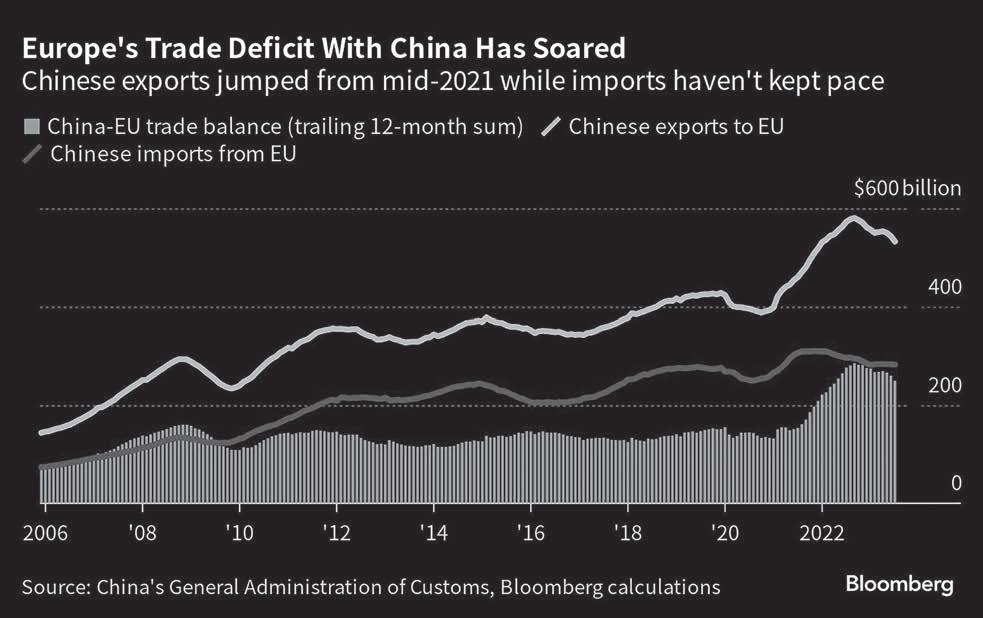
In August, a major EU business group warned that foreign firms in China are suffering from “promise fatigue.” While Xi’s government has pledged in the past year to step up help for private firms and treat
them on par with state-owned ones, overseas companies haven’t seen a ton of tangible progress on much-desired reforms, according to the European Union Chamber of Commerce in China.
Toughening up
CHINA needs foreign capital and knowledge “for its own modernization program,” said Peter Hefele, policy director focused on China at the Wilfred Martens Centre for European Studies. “Next to the US, Europe is the only region to acquire those critical factors.”
It is no secret that the EU is an important economic partner for China, both as market for exports and as investor in the Chinese market,” said Francesca Ghiretti, an analyst at the Mercator Institute for China Studies research firm. Eu rope’s value to China was laid bare last year when the bloc’s trade deficit with Beijing for goods reached more than $400 billion. Dombrovskis said the huge spike in recent years had prompted cause for scrutiny.
The EU unveiled a new economic security strategy earlier this year seeking oversight of critical technology exports, a signal the bloc is edging closer to Washington’s approach toward Beijing. The US has imposed a slew of trade curbs on China to hold back Beijing’s military development as tensions flare over Xi’s territorial ambitions toward the self-ruled island of Taiwan.
There’s no doubt the EU is being more assertive,” said André Sapir, senior fellow at Bruegel and former economic adviser to former EU President Romano Prodi. He pointed to the announcement of the EV probe as a symbol of that, having been delivered by von der Leyen in her state of the union address. “It’s partly to send a message to the Chinese that we are toughening up.”
in mornings because rains come in the afternoon.
At the mouth of the cave, Fernandez would be reminding each batch of 10 visitors to observe proper decorum and wearing of helmets. Occasionally, she would brief some DENR personnel of the throng of non-biting wasps at one of the exposed stalactites at the cave entrance.
At the end of the Su’bon Cave lies a 40-foot vertical drop with a diameter of four meters, concealed by trees and tall grasses. While there is a path ahead, the guides have advised against human entry to safeguard the development of delicate cave features that remain soft and fragile to the touch.
Continued from A1
vironment and Natural Resources (DENR). It was assessed since 2018 and the DENR gave the green light for public spelunking in 2021.

On its social media page, the DENR regional office described Su’bon Cave as one of numerous caves yet to be explored and to be assessed. “The Su’bon Cave in Sitio Talambato in Barangay Asbang and Labas Bantong Cave in Barangay Colonsabac have already exhibited splendid features that can attract nature lovers, thrill seekers and cave enthusiasts.”

Both caves are classified Class 2, which are caves having areas or portions with hazardous conditions and contain sensitive geological, biological, archaeological, cultural and historical values or high-quality ecosystem. It may be necessary to close these sections seasonally or permanently. Class 2 caves are open to experienced cavers or guided educational tours/ visits,” it added.
Sabornido said other caves would be also explored but the processing time of at least three years for each cave would be impossible
to have all of them opened for spelunking soon.
The caves’ opening happened to be within private properties, although Republic Act 9072, an Act to Manage and Protect Caves and Cave Resources and for other purposes, places caves under State management and protection.
The management team of the Matanao caves charges P200 for the cave visit, which they consider affordable and attractive for visitors. They mentioned that in the future, if they offer more challenging adventures, they might consider increasing the fees.
Due to the pandemic, the promotion and opening of the caves have been conducted online up to this day. The town’s social media page has already garnered 17,000 followers, and booking and registration are now exclusively done through online platforms.
The town also tapped the Blaan residents, like Fernandez, to be trained and employed as cave guides. “They are a shy people before, but look at them now. They are as capable and very adept at what they are doing,” she added.
Spelunking is conducted only
Year round SPELUNKING is available yearround, Sabornido said, and the town has opened the cave festival as a regular activity held in May. Then another festivity would happen the following month, in June, as Matanao observes its founding anniversary.
By October, the town would host an extreme sports challenge, and this year, it would be the second edition of Matanao Mountain Marathon, on October 14 and 15.
On its social media page, it said the event “is now part of the international race calendar of Asia Trail Master (ATM) in Hong Kong as Championship points and Grandmaster quest points. With only 4 categories -6km, 21km, 42km and 70km mountain madness that showcase most of the hidden gems of Matanao—caves, waterfalls, peaks and beautiful ridges.”
There are waterfalls located near the caves in Sitio Talambato, which offer a panoramic view of the mountains and stretch as far as the neighboring province of Sultan Kudarat.
“ We are really blessed with natural endowments in this town,” Sabornido said.
AS Europe’s top trade chief headed to Beijing this month shortly after announcing a probe into China’s electric vehicle (EV) subsidies, some in the bloc braced for fiery criticism and any hint of retaliation.• Editor: Angel R. Calso By Jon Marcus The Hechinger Report
BOSTON—Like a lot of high school students, Kevin Tran loves superheroes, though perhaps for different reasons than his classmates.
“They’re all insanely smart. In their regular jobs they’re engineers, they’re scientists,” said Tran, 17. “And you can’t do any of those things without math.”
Tran also loves math. This summer, he studied calculus five hours a day with other high schoolers in a program at Northeastern University.
But Tran and his friends are not the norm. Many Americans joke about how bad they are at math, and already abysmal scores on standardized math tests are falling even further.
The nation needs people who are good at math, employers say, in the same way motion picture mortals need superheroes. They say America’s poor math performance isn’t funny. It’s a threat to the nation’s global economic competitiveness and national security.
US math crisis
THE Education Reporting Collaborative, a coalition of eight newsrooms, is documenting the math crisis facing schools and highlighting progress. Members of the Collaborative are AL.com, The Associated Press, The Christian Science Monitor, The Dallas Morning News, The Hechinger Report, Idaho Education News, The Post and Courier in South Carolina, and The Seattle Times.
“The advances in technology that are going to drive where the world goes in the next 50 years are going to come from other countries, because they have the intellectual capital and we don’t,” said Jim Stigler, a psychology professor at the University of California, Los Angeles, who studies the process of teaching and learning subjects including math.
The Defense Department has called for a major initiative to support education in science, technology, education and math, or STEM. It says there are eight times as many college graduates in these disciplines in China and four times as many engineers in Russia as in the United States.
“This is not an educational question alone,” said Josh Wyner, vice president of The Aspen Institute think tank. In July, the think tank warned that other nations, particularly China, are challenging America’s technological dominance. “Resolving the fundamental challenges facing our time requires math.”
Meanwhile, the number of jobs in math occupations—positions that “use arithmetic and apply advanced techniques to make calculations, analyze data and solve problems”— will increase by more than 30,000 per year through the end of this decade, Bureau of Labor Statistics figures show. That’s much faster than most other kinds of jobs.
“Mathematics is becoming more and more a part of almost every career,” said Michael Allen, who chairs the math department at Tennessee Technological University.
Tennessee Tech runs a summer camp teaching cybersecurity, which requires math, to high school students. “That lightbulb goes off and they say, ‘That’s why need to know that,’” Allen said. Computer-related jobs—ranging from software development to semiconductor production—require math, too. Analysts say those fields have or will develop labor shortages.
Poor math skills
BUT most American students aren’t prepared for those jobs. In the most recent Program for International Student Assessment tests in math, or PISA, US students scored lower than their counterparts in 36 other education systems worldwide. Students in China scored the highest. Only one in five college-bound American high school students is prepared for college-level courses in STEM, according to the National Science and Technology Council.
One result: Students from other countries are preparing to lead these fields. Only one in five graduate students in math-intensive subjects including computer science and electrical engineering at US universities is an American, the National Foundation for American Policy reports. The rest come from abroad. Most will leave the US when they finish their programs.
In the US, poor math skills could mean lower salaries for today’s kids. A Stanford economist has estimated that, if US pandemic math declines are not reversed, students now in kindergarten through grade 12 will earn from 2% to 9% less over their careers, depending on what state they live in, than their predecessors educated just before the start of the pandemic.
But it also means the country’s productivity and competitiveness could slide.
“Math just underpins everything,” said Megan Schrauben, executive director of the Michigan Department of Labor and Economic Opportunity’s MiSTEM initiative, which tries to get more students into STEM. “It’s extremely important for the future prosperity of our students and communities, but also our entire state.”
In Massachusetts, employers are anticipating a shortage over the next five years of 11,000 workers in the life sciences alone.
“It’s not a small problem,” said Edward Lambert Jr., executive director of the Massachusetts Business Alliance for Education. “We’re just not starting students, particularly students of color and from lower-resourced families, on career paths related to math and computer science and those things in which we need to stay competitive, or starting them early enough.”
The Bridge to Calculus program at Northeastern, where Kevin Tran spent his summer, is one response to that. The 113 participating students were paid $15 an hour, most of it from Boston and its public schools, said the program’s coordinator, Bindu Veetel. The university provided the classroom space and some of the teachers.
The students’ days began at 7:30 a.m., when teacher Jeremy Howland had them run exercises in their heads. “Bada-bing,” Howland said whenever they were right.
Students learned to apply that knowledge in coding, data analysis, robotics and elementary electrical engineering classes.
It’s not just a good deed that Northeastern is doing. Some of the graduates of Bridge to Calculus end up enrolling there and proceeding to its highly ranked computer science and engineering programs, which—like those at other US universities—struggle to attract homegrown talent.
These American high school students said they get why their classmates don’t like math.
“It’s a struggle. It’s constant thinking,” said Steven Ramos, 16, who said he plans to become a computer or electrical engineer instead of following his brother and other relatives into construction work.
But with time, the answers come into focus, said Wintana Tewolde, also 16, who wants to be a doctor. “It’s not easy to understand, but once you do, you see it.”
Peter St. Louis-Severe, 17, said math, to him, is fun. “It’s the only subject I can truly understand, because most of the time it has only one answer,” said St. Louis-Severe, who hopes to be a mechanical or chemical engineer.
Not everyone is convinced that a lack of math skills is holding America back.
What employers really want “is trainability, the aptitude of people being able to learn the systems and solve problems,” said Todd Thibodeaux, president and CEO of CompTIA, an information technology trade association. Other countries, he said, “are dying for the way our kids learn creativity.”
Back in class, the students fielded Howland’s questions about polynomial functions. And after an occasional stumble, they got all the exercises right.
“Bada-bing,” their teacher happily responded.
T he Associated Press education team receives support from the Carnegie Corporation of New York. The AP is solely responsible for all content.

Australian-born Angus Murray, a former executive at asset manager Macquarie Group Ltd., has signed a deal to buy the tunnels from Britain’s former state telecom monopoly, BT Group Plc, and has a four-year makeover strategy for the site. The Kingsway Telephone Exchange, as it is officially known, occupies 8,000 square meters (86,111 square feet), 40 meters below the lawyers’ offices that characterize London’s Holborn district.
Through his company, the London Tunnels Ltd., Murray plans to line cavernous, cylindrical rooms with gigantic screens to create immersive, blockbusterinspired experiences. He hopes to strike deals with such Hollywood studios as Harry Potter-series maker Warner Bros. Discovery and Amazon.com Inc., which now owns the rights to James Bond.
At the same time, he wants to preserve parts of its history, such as what he says was the UK’s deepest bar, which was frequented by the engineers and clerks who worked underground. Later, they made sure the first trans-Atlantic telecommunications line kept running in order to carry diplomatic emergency calls during the Cold War.
“Would I compare this to be as iconic as the London Eye? Yes, I would,” Murray says during a tour of the tunnels in August. “Who wouldn’t come here?”
The history
THE tunnels were built in 1941 and 1942 to be used as deep shelters from air raids during the London Blitz. They were completed after the worst of the bombing was over, so they were never used for that purpose, according to historians at BT. By 1944, they were being used by the dull-sounding Inter-Services Research Bureau.
The ISRB was, in fact, a cover name for the Special Operations Executive (SOE), an espionage organization that is sometimes called “Churchill’s Secret Army.” It operated across war-torn Europe and eventually became part of MI6, the UK’s foreign intelligence service.
James Bond creator Ian Fleming was a liaison officer to the SOE, which under the ISRB code name developed eccentric weapons and booby traps similar to those offered by “Q Branch” in the Bond books and films. They would stuff rat skins with explosives, for example, and build dummy logs that hid munitions, according to the Natural History Museum, which housed one of the group’s top-secret workshops. The UK Foreign Office, which is responsible for MI6, didn’t respond to a request for comment.
SOE equipment was removed from the tunnels on VE Day
in 1945, BT says. The tunnels were used as a secure “reserve war room,” to store 400 tons of highly sensitive documents. They later hosted the secure hotline that connected the presidents of the US and Soviet Union during the Cold War.
Ownership was eventually transferred to the General Post Office, which became BT, Britain’s state-operated phone company. BT was privatized by Prime Minister Margaret Thatcher in 1984, and the tunnels were deemed obsolete by the ’90s.
The deal
BT put the tunnels up for sale about 15 years ago. To buy them, Murray put in roughly £12 million of his own money, plus financing from his private equity firm, which runs under the brand of his fund, Castlestone Management LLC.
An initial phase to bring the site “up to construction” will cost about £40 million and will take until the end of next year. Murray says he’s secured commitments from investors for that work. The tunnels will then need fitting out with modern amenities and a shell that meets health and safety approvals. This will cost a further £100 million. He has hired Wilkinson Eyre Ltd., the architects who worked on the recent £9 billion revamp of London’s Battersea Power Station.
Murray estimates that a further £80 million will be needed to get the space ready for the public by 2027. As well as seeking partnership with such entertainment companies as Walt Disney Co., Murray plans partnerships with manufacturers such as Samsung Electronics Co. or LG Corp. He says he’s already started those conversations. The tunnels have room for eight times as many screens as the famous advertising display that dominates London’s Piccadilly Circus junction, he says.
Immersive experiences and screen-based attractions like Las Vegas’s new Sphere have become more popular as technology has improved. However, the lack of natural light and ways to orient oneself might be a problem, according to Catherine Allen, founder of research organization and consultancy Limina Immersive, which specializes in the responsible use of immersive technology.
“In 2015, I queued for an immersive art exhibition in London, but the headsets smelt awful and the content made me and my colleagues dizzy,” she said. “At a separate immersive experience in the north of England in the mid-2010s, I witnessed a man have a panic attack while on one of the rides.”
The man
is a passion project for
Murray, a larger-than-life character with a background that’s mainly in finance rather than tourism or entertainment.
In 2011, his fund Castlestone faced a raid by British regulators in the wake of the 2008 financial crash. Murray shut Castlestone’s British and Irish operations shortly after that probe; he says they had become uneconomical.
The business was already eroding due to the shift from active asset management to index investing, Murray says. The news stories prompted client concern, but he ultimately faced no disciplinary or regulatory action, according to the Financial Conduct Authority’s site. He still operates Castlestone in the US.
While he’s wearing a hard hat, Murray remains very much the banker when reeling off details of the business plan. He estimates the tunnels’ safe capacity at 2 million visitors a year, or 625 per hour. With an entry price around £30, that amounts to £60 million in annual revenue. He projects margins for earnings before interest and tax at a precise 38%. If the fully upand-running project were valued with a multiple similar to that of the buyout of British theme-park operator Merlin Entertainments, that would make it worth about £270 million.
The odds

THAT’S a lot of ifs. The biggest immediate threat to Murray’s dream is probably Britain’s planning system.
He’s in consultation with Camden and the City of London’s councils. He says they should appreciate the benefits of a new attraction that could draw investment to a part of London that, while nestled among such tourist spots as the British Museum and Saint Paul’s Cathedral, has few attractions itself.
Development decisions in the UK are in the hands of local councils. Residents are invited to share their views before voting on applications takes place, a process that can choke ambitious commercial projects.
More than one in 10 applications for commercial develop -
ments failed to secure permission in the year ending March 2023, according to government statistics. The building of a new Disney-style theme park near London—which at one point had the backing of Hollywood studio Paramount Global—was stymied after the discovery of a rare spid er whose habitat was deemed to be at risk. This year, the developer behind that proposal went into administration.
The People’s Republic of China also suffered a recent defeat in this system. Its plan for a new embassy near the Tower of London was unanimously rejected by Tower Hamlets Council in December, following dozens of complaints from residents worried about safety as well as eager to maintain the site’s heritage. While applicants can appeal to an independent reviewer, it’s an expensive process that can take many weeks to conclude. Beijing found it strange that local officials could block such a move—seeing it as a matter for the national government rather than regional planners—but decided not to appeal the decision.
To see the tunnels in their current state, visitors have to find a discreet entrance in an alleyway and then don a hard hat, highvisibility clothing and steel-toecap boots. Then they descend into a warren of parallel tunnels that total a mile in length, with smaller side branches.
In some areas, rotary telephones sit beside hulking, Britishbuilt diesel generators and other long-defunct machinery. Other areas have decades-old wallpaper and furniture. Much of the space is completely bare, apart from occasional bits of graffiti from bold urban explorers.
A couple of asbestos warnings are posted. Murray says all dangerous materials will be removed. The London Underground’s Central line rumbles loudly above—a noise he concedes will be impossible to eradicate.
For now, he sees unique value and potential. “Where can you get 8,000 square meters of historic novelty in London,” he asks, “that’s got a billion dollar reconstruction valuation?”
By Thomas Seal & Damian Shepherd
AWARREN of tunnels beneath central London, once used by the spies who inspired the creation of James Bond, has been bought by a fund manager with a £220 million ($269 million) plan to turn them into a tourist attraction “as iconic as the London Eye.”
America’s poor math skills raise alarms over global competitiveness
THE Afghan man speaks only
Farsi, but he wasn’t worried about representing himself in US immigration court. He believed the details of his asylum claim spoke for themselves.
Mohammad was a university professor, teaching human rights courses in Afghanistan before he fled for the United States. Mohammad is also Hazara, an ethnic minority long persecuted in his country, and he said he was receiving death threats under the Taliban, who reimposed their harsh interpretation of Sunni Islam after taking power in 2021.
He crossed the Texas border in April 2022, surrendered to Border Patrol agents and was detained. A year later, a hearing was held via video conference. His words were translated by a court interpreter in another location, and he said he struggled to express himself—including fear for his life since he was injured in a 2016 suicide bombing.
At the conclusion of the nearly three-hour hearing, the judge denied him asylum. Mohammad said he was later shocked to learn that he had waived his right to appeal the decision.
“I feel alone and that the law wasn’t applied,” said Mohammad, who spoke to The Associated Press on condition that only his first name be used, over fears for the safety of his wife and children, who are still in Afghanistan.
Mohammad’s case offers a rare look inside an opaque and overwhelmed immigration court system where hearings are often closed, transcripts are not available to the public and judges are under pressure to move quickly with ample discretion. Amid a major influx of migrants at the border with Mexico, the courts—with a backlog of 2 million cases—may be
the most overwhelmed and least understood link in the system.
AP reviewed a hearing transcript provided by Mona Iman, an attorney with Human Rights First now representing Mohammad.
Iman also translated Mohammad’s comments to AP in a phone interview from Prairieland Detention Center in Alvarado, Texas.
The case reflects an asylum seeker who was ill equipped to represent himself and clearly didn’t understand what was happening, according to experts who reviewed the transcript. But at least one former judge disagreed and said the ruling was fair.
Now Mohammad’s attorney has won him a new hearing, before a different judge—a rare second chance for asylum cases. Also giving Iman hope is a decision this week by the Biden administration to give temporary legal status to Afghan migrants living in the country for more than a year.
Iman believes he qualifies and said he will apply.

But Mohammed has been in detention for about 18 months, and he fears he could remain in custody and still be considered for deportation.
AP sought details and comment from US Immigration and Customs Enforcement. The agency didn’t address questions on Mohammad’s case but said noncitizens can pursue all due process and appeals and, once that’s exhausted, judges’ orders must be carried out.
He argued his case FOR his April 27 hearing, Mohammad submitted photos of his injuries from the 2016 suicide bombing that killed hundreds at a peaceful demonstration of mostly Hazaras. He also gave the court threatening letters from the Taliban and medical documents from treatment for head wounds in 2021. He said militants beat him with sticks as
he left the university and shot at him but missed.
In court, the government argued that Mohammad encouraged migration to the US on social media, changed dates and details related to his history, and had relatives in Europe, South America and other places where he could have settled.
In ruling, Judge Allan JohnBaptiste said the threats didn’t indicate Mohammad would still be at risk, and that his wife and children hadn’t been harmed since he left.
Mohammad tried to keep arguing his case, but the judge told him the evidentiary period was closed. He asked Mohammad whether he planned to appeal or would waive his right to do so.
Mohammad kept describing his claim, but John-Baptiste reminded him he’d already ruled. Mohammad said if the judge was going to ignore the humanitarian situation in Afghanistan, he wouldn’t ask for an appeal. John-Baptiste indicated he had considered it.
“You were not hit by the gun -
shot or the suicide bomber,” JohnBaptiste said. “The harm that you received does not rise to the level of persecution.”
Mohammad continued, explaining how his family lives in hiding, his wife concealing her identity with a burqa.
“OK, are you going to appeal my decision or not?” John-Baptiste ultimately asked.
“No, I don’t,” Mohammad said.
“And we don’t want you to make the decision now that you can’t come back later and say you want to appeal. This is final, OK, sir?”
John-Baptiste said.
“Yes. OK, I accept that,” Mohammad said. He later asked whether he could try to come back legally. The judge started to explain voluntary departure, which would allow him to return in less than a decade, but corrected himself and said Mohammad didn’t qualify.
“I’m sorry about that, but, you know, I’m just going to have to order you removed,” John-Baptiste said. “I wish you the best of luck.”
Mohammad later told AP he couldn’t comprehend what was happening in court. He’d heard from others in detention that he had a month to appeal.
“I didn’t understand in that moment that the right would be taken from me if I said no,” he said.
Case reopened FORMER immigration judge Jeffrey Chase, who reviewed the transcript, said he was surprised JohnBaptiste waived Mohammad’s right to appeal and that the Board of Immigration Appeals upheld that decision. Case law supports granting protection for people who belong to a group long persecuted in their homelands even if an individual cannot prove specific threats, said Chase, an adviser to the appeals board.
But Andrew Arthur, another former immigration judge, said John-Baptiste ruled properly.
“The respondent knew what he was filing, understood all of the questions that were asked of him at the hearing, understood the decision, and freely waived his right to appeal,” Arthur, a fellow at the Center for Immigration Studies, which advocates for immigration restrictions, said via email.
Chase said the hearing appeared rushed, and he believes the case backlog played a role.
“Immigration judges hear death-penalty cases in trafficcourt conditions,” said Chase, quoting a colleague. “This is a perfect example.”
Overall, the 600 immigration judges nationwide denied 63 percent of asylum cases last year, according to Syracuse University’s Transactional Records Access Clearinghouse. Individual rates vary wildly, from a Houston judge who denied all 105 asylum requests to a San Francisco one denying only 1 percent of 108 cases.
John-Baptiste, a career prose -
cutor appointed during the Trump administration’s final months, denied 72 percent of his 114 cases.
Before Mohammad decided to flee, his wife applied for a special immigrant visa, which grants permanent residency to Afghans who worked for the US government or military, along with their families.
But that and other legal pathways can take years. While they waited, Mohammad said, the Taliban came looking for him but instead detained and beat his nephew. Mohammad described making the devastating decision to leave his family, who had no passports.
He opted for a treacherous route through multiple countries to cross the US-Mexico border, which has seen the number of Afghans jump from 300 to 5,000 in a year.
Mohammad said he crossed into Pakistan, flew to Brazil and headed north. He slept on buses and trekked through Panama’s notorious Darien Gap jungle, where he said he saw bodies of migrants who didn’t make it.
Mohammad planned to live with a niece in North Carolina. Now he fears if he’s sent home and his wife gets her visa, they’ll be separated again.
Deportations to Afghanistan are extremely rare, with a handful each year.

Attorney Iman said they’re grateful Mohammad’s case has been reopened, with a hearing scheduled for Oct. 4. She is fighting for his immediate release.
“I have no doubt that his case would have turned out differently had he been represented,” Iman said. “This is exactly the type of vulnerable individual that the US government has promised, has committed to protect, since it withdrew from the country.”
The Associated Press reporter Elliot Spagat contributed from San Diego.
LONDON—Wildfires fueled by climate change have ravaged communities from Maui to the Mediterranean this summer, killing many people, exhausting firefighters and fueling demand for new solutions. Enter artificial intelligence.
Firefighters and startups are using AI-enabled cameras to scan the horizon for signs of smoke. A German company is building a constellation of satellites to detect fires from space. And Microsoft is using AI models to predict where the next blaze could be sparked.
With wildfires becoming larger and more intense as the world warms, firefighters, utilities and
governments are scrambling to get ahead of the flames by tapping into the latest AI technology — which has stirred both fear and excitement for its potential to transform life. While increasingly stretched first responders hope AI offers them a leg up, humans are still needed to check that the tech is accurate.
California’s main firefighting agency this summer started testing an AI system that looks for smoke from more than 1,000 mountaintop camera feeds and is now expanding it statewide. The system is designed to find “abnormalities” and alert emergency command centers, where staffers will confirm whether it’s indeed smoke or something else in the air.
“The beauty of this is that it immediately pops up on the screen and those dispatchers or call takers are able to interrogate that screen” and determine whether to send a crew, said Phillip SeLegue, staff chief of intelligence for the California Department of Forestry and Fire Protection.
The cameras, part of a network that workers previously had to watch, provide billions of bytes of data for the AI system to digest. While humans still need to confirm any smoke sightings, the system helps reduce fatigue among staffers typically monitoring multiple screens and cameras, alerting them to look only when there’s possible fire or smoke, SeLegue said.
It’s already helped. A battalion chief got a smoke alert in the middle of the night, confirmed it on his cellphone and called a command center in San Diego to scramble first responders to the remote area.
The dispatchers said that if they hadn’t been alerted, the fire would have been much larger because it likely wouldn’t have been noticed until the next morning, SeLegue said.
San Francisco startup Pano AI takes a similar approach, mounting cameras on cell towers that scan for smoke and alert customers, including fire departments, utility companies and ski resorts.
The cameras use computer vision machine learning, a type of AI.
“They’re trained very specifi -
cally to detect smoke or not, and we train them with images of smoke and images of not smoke,” CEO Sonia Kastner said.
The images are combined with feeds from government weather satellites that scan for hotspots, along with other data sources, such as social media posts.
The technology gets around one of the main problems in the traditional way of detecting wildfires — relying on 911 calls from passers-by that need confirmation from staffers before crews and water-dropping planes can be deployed.
“Generally, only one in 20 of these 911 calls are actually a wildfire. Even during fire season, it might be a cloud or fog or a barbecue,” Kastner said.
Pano AI’s systems do still rely on final confirmation, with managers playing a time lapse of the camera feed to ensure it’s smoke rising.
For fighting forest fires, “technology is becoming really essential,” said Larry Bekkedahl, senior vice president of energy delivery at Portland General Electric, Oregon’s largest utility and a Pano AI customer.
Utility companies sometimes play a role in sparking wildfires, when their power lines are knocked down by wind or struck by falling trees. Hawaii’s electric utility acknowledged that its power lines started a devastating blaze in Maui this summer after apparently being downed by high winds.
PGE, which provides electricity to 51 cities in Oregon, has deployed 26 Pano AI cameras, and Bekkedahl said they have helped speed up response and coordination with emergency services.
Previously, fire departments were “running around looking for stuff and not even really knowing exactly where it’s at,” he said. The cameras help detect fires quicker and get teams on the ground faster, shaving up to two hours off response times.
“That’s significant in terms of how fast that fire can can spread and grow,” Bekkedahl said.
Using AI to detect smoke from fires “is relatively easy,” said Juan Lavista Ferres, chief data scientist at Microsoft.
“What is not easy is to have enough cameras that cover enough places,” he said, pointing to vast, remote areas in northern Canada that have burned this summer.
Ferres’ team at Microsoft has been developing AI models to predict where fires are likely to start. They have fed the model with maps of areas that burned previously, along with climate and geospatial data.
The system has its limitations—it can’t predict random events like a lightning strike. But it can sift through historical weather and climate data to identify patterns, such as areas that are typically drier. Even a road, which indicates people are nearby, is a risk factor, Ferres said.
“It’s not going to get it all perfectly right,” he said. “But what it can do is it can build a probability map (based on) what happened in the past.”
The technology, which Microsoft plans to offer as an open source tool, can help first responders trying to figure out where to focus their limited resources, Ferres said.
Another company is looking to the heavens for a solution. German startup OroraTech analyzes satellite images with artificial intelligence.
Taking advantage of advances in camera, satellite and AI technology, OroraTech has launched two mini satellites about the size of a shoebox into low orbit, about 550 kilometers (340 miles) above Earth’s surface. The Munich-based company has ambitions to send up eight more next year and eventually put 100 into space.
As wildfires swept central Chile this year, OroraTech said it provided thermal images at night when aerial drones are used less frequently.
Weeks after OroraTech launched its second satellite, it detected a fire near the community of Keg River in northern Alberta, where flames burned remote stretches of boreal forest repeatedly this summer.
THE government has been encouraging Filipino scientists, who are working or living abroad, to return to the country as Balik Scientists for a limited period to serve the country through their respective expertise in research and development (R&D). But many of them are opting to stay and serve in the country longer, if not for good. Should they be called “stay scientists”?
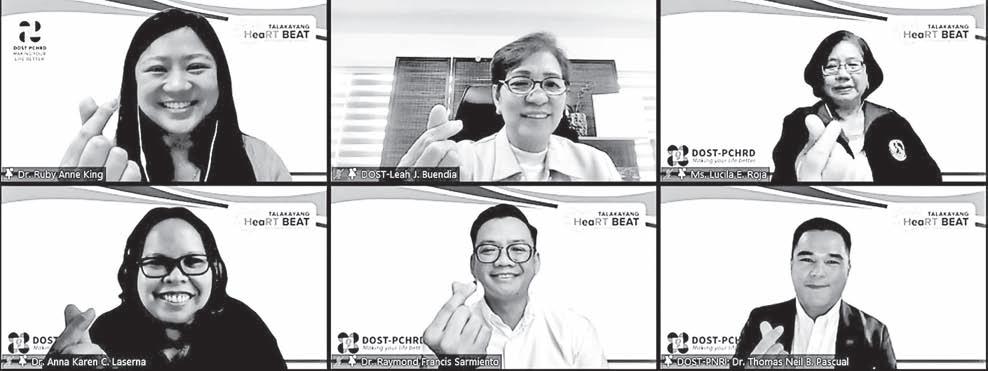
The Filipino scientists are motivated to return in order to contribute and help improve the country’s capacity in science, technology and innovation (STI) in several sectors, including health, agro-industry, energy and economy.
Through the Balik Scientist Program (BSP) of the Department of Science and Technology (DOST), Undersecretary for R&D Leah Buendia highlighted its importance in addressing the country’s brain drain, or the departure of educated and skilled professionals for better opportunities abroad.
“The return of the scientists is a big help to lessen the country’s brain drain,” Buendia said during the recent Talakayang HeaRT Beat that was held by the DOST-Philippine Council for Health Research and Development (DOST-PCHRD).
The scientists are given the opportunity to collaborate with experts and researchers both local and foreign, which the DOST told the BusinessMirror , is “an important step toward the development of the health sector in the country.”
Three Balik Scientists involved in health shared their experiences and current projects during the
virtual Talakayang HeaRT Beat news conference.
The Balik Scientists in health
FROM the National University of Singapore, Dr. Anna Karen Laserna specializes in analytical science and is now an Academic Service Faculty at De La Salle University.
During her engagement with BSP, Laserna helped establish the De La Salle University-Central Instrumentation Facility that led to its becoming a Center of Research in Metabolomics, and a partner institution of the DOST-PCHRD in the Tuklas Lunas Program.
Director of National Telehealth Center, Dr. Raymond Francis Sarmiento received his training in biomedical and health informatics from the United States National Institutes of Health and in Center for Disease Control and Prevention.
Sarmiento developed a technical proposal about telemedicine protocols and systems, developed a new Newborn Hearing Screening module, and was the mind behind the vaccine certificate.
Dr. Neil Thomas Pascual, an S&T Fellow at DOST-Philippine Nuclear Research Institute, was from the International Atomic Energy Agency in Vienna.
As a Balik Scientist, Pascual is heading the establishment of the Nuclear Medicine Research Development and Innovation Center, and the development of the Nuclear Medicine Research Agenda.
‘Still more to be done’ THE future of health R&D looks
promising with these Balik Scientists’ contributions.
Looking into the larger picture, Sarmiento said in Filipino: “There’s still more to be done.”
He shared that progress and advancement vary between the country he was trained in and in the Philippines, adding that Balik Scientists must think about how they could help advance or improve the current state of the Philippines’ R&D instead of saying “we’re still at this level.”
“It is not to say that we’re behind [other countries], but if it’s a timeline, we [the Philippines and other countries] have different levels of maturity,” he said.
Sarmiento proposed a “targeted recruitment” by identifying which areas in the health sector need more push so that the people already in that field would have like-minded individuals to support each other and expedite
the process. Laserna lamented the oft-repeated experience of Balik Scientists of delayed acquisition of reagents, chemicals and equipment for research that is “something that has to be addressed.”
“We can ask for help from other government agencies on what we could do,” she suggested.
Future plans; staying longer, permanently
THE three scientists intend to “stay in the country longer” in order to impart what they have learned, foster collaboration, create a lasting impact in the health sector and focus on their projects. This led the forum moderator, Dr. Ruby Anne King, to tag them as “stay scientists.” The BSP provides limited short-, medium- and long-term tenures, which are good for sixmonth, one-year or three-year
THE Philippines improved its Global Innovation Index (GII) 2023 ranking by climbing three steps upward to 56th, from 59th in 2022.
The country’s ranking started its zigzag slide in 2021 when it ranked 51st from its highest rank of 50th in 2020, shows the World Intellectual Property Organization (WIPO), a specialized agency of the United Nations, which publishes the GII.
The country’s GII 2023 accomplishment was accompanied with its being listed among those in the lower middle-income group with performance “above expectation for their level of development.”
With the Philippines are India, Vietnam, Ukraine, Indonesia, Iran Mongolia, Morocco, Tunisia, Uzbekistan, Pakistan and Senegal, among 37 economies, the WIPO website says. With innovation being recognized as key driver of economic development, it provides ranking and analysis referencing around 132 economies.
The GII 2023 captures the innovation ecosystem performance of 132 economies and tracks the most recent global innovation trends.
The pack is topped by Switzerland, Sweden, United States, United Kingdom, Singapore, Finland, the Netherlands, Germany, Denmark and Republic of Korea as the top 10
in that order.
Those at the bottom are Cameroon, Burkina Faso, Ethiopia, Mozambique, Mauritania, Guinea, Mali, Burundi, Niger and Angola, the WIPO web site shows.
For its GII 2023 score, the Philippines’ high ranks are in Business Sophistication (38th), Knowledge and Technology outputs (46th) and Market Sophistication (55th).
It ranks low in Institutions (79), Human Capital and Research (88), Infrastructure (86) and Creative Outputs (60).
The Philippines is among the Top Climbers in the decade 2013-2023, placing it among the top 60 countries together with Indonesia, but
behind Vietnam, which is among the top 50, according to the WIPO website.
The report notes that in 2013 the Philippines ranks 90th.
It adds that the Philippines and Morocco (ranked 70th) “keep their innovation overperformer status for a fifth time.” The Philippines’ overperformance were from 2019 to 2023.
In the last four years, the Philippines consistently performed better in innovation outputs, compared to innovation inputs.
The year 2023 was no exception it being in 69th place in innovation inputs, compared to 76th in 2022, 72nd in 2021 and 70th in 2020.
For innovation outputs, the Philippines scored 52nd place in 2023, compared to 51st in 2022, 40th in 2021 and 41st in 2020.
Science Secretary Renato U. Solidum Jr. welcomed the Philippines’ improvement in its GII ranking, the Department of Science and Technology (DOST) said.
“The DOST shall remain focused on driving the country’s science, technology, and innovation-driven economic development by continuously investing in programs and projects that can advance the country’s productivity and competitiveness in the global knowledge economy,” Solidum said.
Our good performance in innovation outputs compared to inputs is reflective of our country’s ability to translate our innovation investments,” he added.
Solidum said the DOST “hopes to support our local companies to drive innovation and wealth, with banner programs like the DOST’s Science for Change Program, Small Enterprise Technology Upgrading Program and the Community Empowerment thru Science and Technology program.”
He said that in the next four years the DOST is “optimistic to see incremental improvements in the country’s GII ranking as we dedicatedly review our policies, programs, and strategies.”
Lyn ResurreccionTHE Seven Lakes of San Pablo, Laguna, known for their diverse ecosystem services, including ecotourism, aquaculture and cultural significance were recently assessed for their water quality.
The water quality assessment revealed notable variations among the lakes during different months, including the presence of various types of algae both beneficial and harmful to living organisms in the lakes.
This was done through the project, "Development of Models for the Assessment and Monitoring of the Seven Lakes of San Pablo," implemented by the University of the Philippines Los Baños (UPLB) and led by John Vincent R. Pleto.
Funded by the Philippine Council for Agriculture, Aquatic and Natural Resources Research and Development of the Department of Science and Technology (DOST-PCAARRD), the project primarily aimed to assess and
monitor the lakes’ water quality.
In May 2022, the lakes primarily used for fish farming, boating and fishing exhibited above-the-recommended levels of dissolved oxygen, which may harm aquatic life and affect water quality.
However, in August 2022, the water quality of ecotourism lakes, such as Pandin, Yambo, Mohicap and Sampaloc, indicated satisfactory levels showing a healthy and functioning ecosystem.
One of the key observations was the prevalence of Microcystis, a type of blue-green algae, across the Seven Lakes. The presence of Microcystis can have an impact on other organisms, such as green algae and diatoms, which play essential roles in the ecosystem.
A significant change in the dominance of algae was observed in August 2022.
Diatoms, a type of algae, became more
prevalent compared to cyanobacteria, another type of algae.
This drastic change, according to the researchers, may be due to the sediments mixing with the water making it cloudy and thus reducing the amount of sunlight reaching the deeper parts of the lake. This change affects the primary production of algae.
Phytoplankton, another type of algae, can also be found in the lakes. Possible new records of phytoplankton called Dolichospermum can be found in Lake Calibato and Lake Bunot.
Moreover, another type of phytoplankton called Planktothrix may be found in Lake Calibato and Lake Palakpakin. These phytoplankton species produce toxins that are harmful to living organisms in the lakes.
Also found in Lake Calibato is a toxic type of algae called Naiadinium, formerly known as Peridinium, which contributes to fish kills and
periods, with a package of benefits. This means that staying scientists would receive their commensurate remunerations.
Pascual said he would be staying longer, or even permanently, to improve research in the area of cyclotron, radiopharmaceuticals for cancer management, and research collaboration to initiate research in nuclear medicine.
With the aim to improve cancer imaging in the Philippines, Pascual said that if the Nuclear Medicine Research Agenda were approved, “it would open doors for scientists in nuclear medicine and for the next generation.”
Laserna, meanwhile, is planning “to continue the work of capacitating our students and researchers, in terms of analytical science and metabolomics,” while also developing courses and modules on how to make use of analytical instruments as well as
using “omics” technologies like in studying colorectal cancer.
Omics are areas of study of molecular process within an organism. These iinclude proteomics, genomics, metabolomics, lipidomics and epigenomics, which correspond to analyses of proteins, RNA, genes, metabolites, lipids, and methylated DNA, among others.
Sarmiento, as director of the National Telehealth Center, is working toward developing the implementation of national registries to hasten the processing of results of newborn hearing screening.
He is also working on a mental health application that is natural language processing-aided.
“Overall, the goal of the Philippines is to make sure that digital health becomes a facilitator in terms of achieving the successful implementation of Universal Health Care,” Sarmiento said.
BSP from 1975 to 2018
THE Balik Scientist Act (Republic Act 11035) was enacted in 2018 to institutionalize and “to strengthen the [S&T] human resources” to reverse the effect of brain drain, accelerate the flow of technologies and promote knowledge sharing.
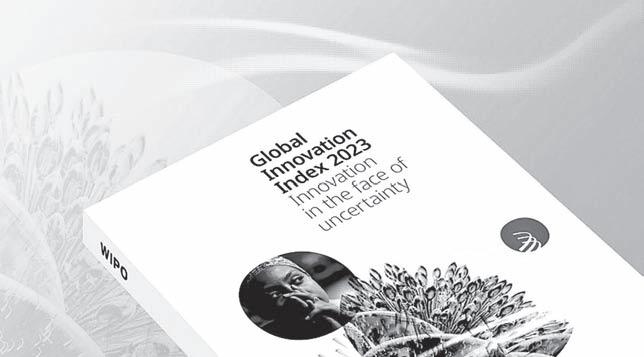
The returning scientists are involved in training local scientists and researchers, R&D and technology transfer.

The BSP, through Presidential Decree 819, was originally established in October 1975. It was revitalized in 2007, with the necessary policies and funding support.
IN celebration of innovation and camaraderie, the Department of Science and Technology-Technology Application and Promotion Institute (DOST-TAPI) is unveiling “Lunduyan 2023” on October 2 at a hotel in Mandaluyong City.
The event will showcase 28 trailblazing technologies and innovation projects from various sectors, including food and manufacturing, health and wellness, agriculture, industry, energy and environment, and micro, small and medium enterprises.
Lunduyan 2023 is not just a convergence point of brilliant minds; “it is where the rich tapestry of the country’s diverse populace, where ingenuity meets experience, where the young and the elderly, the differently-abled, and individuals from every corner of our archipelago—from the highlands of Benguet to the far reaches of Sulu—come together to forge a roadmap to a brighter, more innovative future for the Philippines,” said DOST-TAPI Director Atty. Marion Ivy D. Decena.
“Through DOST-TAPI’s substantial investments in intellectual property and technology development, we are nurturing homegrown talent and elevating Filipino innovations on the global stage,” Decena added.
This venture is backed by a substantial investment portfolio with DOST-TAPI al -
locating over P30 million for invention and technology development and intellectual property rights protection, and more than P12 million for commercialization of MSME projects as of August 30.
Matthew Bryan P. Villanueva, the head of the Applied Communications Unit for noninventors, said: “It is not just an event; it’s our shot at supercharging local innovation, lighting the path to a future guided by our homegrown brilliance.”
“Lunduyan is our platform to spotlight Filipino inventors and innovators, allowing them to introduce their initiatives and amplify their advocacies in science,” Marvin de la Cruz, head of Applied Communications Unit for Inventors said.
The initiative will be graced by the presence of influential personalities including Science Secretary Dr. Renato Solidum and revered DOST-TAPI institutional partners, along with a diverse guests of 200 from national agencies, legislative members, non-profit organizations, CSR companies, private stakeholders, universities, and micro-small medium enterprises.
The event will celebrate the accomplishments of DOST-TAPI’s 2023 call for proposals while drawing in potential partners, funders, and collaborators to support the burgeoning Filipino innovation landscape.
infection in fish gills.
On a positive note, Haematococcus pluvialis, a type of green algae found in Lake Yambo and Lake Sampaloc, produces astaxanthin, an antioxidant beneficial to organisms feeding on them.
Another new record of green algae species, Botryococcus, originally found in Lake Paoay, Ilocos Norte, has been newly observed in Lake Yambo.
Additionally, new records of centric diatoms, Thallasiosira, were discovered mainly in the bottom part of the lake. New records of diatoms, such as the two Epithemia species, were also discovered in Lakes Bunot and Pandin.
This is along with other new records that require further study, including Moraria and Harpacticoid sp. in Lakes Palakpakin and Yambo, respectively, and Paracyclops and Tropocyclops in Lake Mohicap.
The project says further investigation and proper identification are still necessary to ensure accurate identification and better understanding of relationships of the algae species with other organisms and water quality.
Data collected from quarterly assessments and monitoring significantly contributed to the development of the Water Quality Index (WQI) to understand the overall health of the lakes.
Water quality, according to DOST-PCAARRD, plays a crucial role in maintaining a thriving ecosystem and ensuring the well-being of plants, animals and the environment as a whole. Through gained information from the lakes' health, the project hopes for communities to make more informed decisions to ensure sustainable management as well as formulate precautions on maintaining and protecting the lakes and all organisms living in them. Rizza

Albert Alejo of sedition charges they said were used to silence the critics of Duterte.
Villanueva welcomed the ruling and maintained that the charges were fabricated to punish them for their pursuit of justice.
“To say that the charges have been trumped up to silence us is something we never doubted. That was clear to us at the very onset,” he said.
“It was clearly the past administration silencing those who speak the truth,” the priest added.
While they are thankful for the court’s decision, Villanueva said their concern remains the victims of extrajudicial killings (EJK) in Duterte’s drug war that left thousands dead.
“They were not charged but they were killed tragically,” according to Villanueva.
The priest is known for establishing a support group for families of EJK victims. In 2021, he received the prestigious Human Rights Tulip Award from the Dutch government.
release of a viral video on social media platforms in 2019 that linked Duterte and his family to the illegal drug trade.
Among those implicated in the complaint were then Vice President Leni Robredo, three opposition senators, four bishops, three priests and other critics of Duterte’s bloody war on drugs.
The accused all denied the allegations made by a formerly detained crime suspect, Peter Advincula, who claimed that he had conspired with them to discredit Duterte by linking them to drug syndicates.
In 2020, the Justice department dropped the charges against Archbishop Socrates Villegas, and Bishops Pablo Virgilio David, Honesto Ongtioco and Teodoro Bacani, and others accused due to lack of evidence.


Villanueva, on the other hand, wished for the release of former senator Leila de Lima, who remains in jail.
ACATHOLIC parish has called for prayers for truth to prevail in the alleged child abuse and exploitation in a supposed cult group in Surigao del Norte, according to the online CBCP News of the Catholic Bishops’ Conference of the Philippines.
ate Committee on Public Order and Dangerous Drugs, as well as the Committee on Women, Children, Family Relations and Gender Equality.
The issue was raised by Sen. Risa Hontiveros, who urged the Senate to probe the alleged abuse in the Kapihan group.
“So while our acquittal is a call of thanksgiving, there is also a stronger resolve to continue the mission of fighting for justice and unraveling the truth,” said Divine
Word priest Fr. Flaviano “Flavie” Villanueva.
Due to insufficient evidence, a Quezon City court on September 6 cleared Villanueva and Jesuit Fr.
The Metropolitan Trial Court in Quezon City also acquitted all the remaining accused who were allegedly involved in a plot to destabilize the Duterte administration.
The charges stemmed from the
A leading critic of Duterte, de Lima was arrested and detained on drug trafficking charges in 2017 after initiating a Senate probe into the drug war.
“She deserves an immediate acquittal more than us,” Villanueva said. CBCP News
ACATHOLIC bishop has reminded the faithful not to compare themselves to others, as it will only steal their joy.
Bishop Raul Dael of Tandag said that a person can lose their way when they start unnecessary competition with others.
“When we start comparing ourselves with others we will never be happy, we will never be happy,” Dael said in his recent Sunday Mass homily at the Tandag Cathedral.
The bishop urged his flock to instead look at how God has
uniquely blessed them, and they will experience the joy of life.
“If we look into ourselves and see how God has blessed us personally and uniquely, we will experience real joy and happiness,” the bishop said.
Dael also encouraged the faithful to continue serving the church and the community without seeking acknowledgement or recognition.
“We work without comparing ourselves with others. We work for love, not for a pay, but for love,” he said. CBCP News

THE Diocese of Cubao has declared every second Sunday of October as the Solemnity of Our Lady of the Holy Rosary of La Naval.
The mandate “for the spiritual good of the people” was issued in a Declaration dated September 8 by Bishop Honesto Ongtioco of Cubao but was only made public recently.
“The solemnity must be observed in all parishes and chapels beginning this year in accord with the Declaration of Pope Paul VI and with the liturgical norms of the Church,” part of the declaration read.
Ongtioco asked that communities must observe all norms and guidelines in the exercise of this
devotion. “All are likewise encouraged to promote the devotion and put into practice the virtues of the Blessed
Virgin Mary that lead us closer to her Son, Jesus our Lord,” he said. The Declaration came ahead of the October 8 feast of Our Lady of
the Rosary of La Naval, whose revered image is enshrined at the Sto. Domingo Church in Quezon City.
Since 1646, the second Sunday of October each year has been celebrated in honor of Our Lady of La Naval.

The annual celebration is highlighted with a street procession that attracts thousands of devotees.
The first procession was held on October 6, 1646, in Manila to commemorate the naval victory of the Spanish-Philippine defenders over the Protestant Dutch invaders in the 17th century.
This year also marks the 50th year since La Naval de Manila became the patroness of the city.
CBCP News
is typically paired with a headscarf to cover the hair. This garment finds its primary usage in North Africa; the Horn of Africa, which includes countries such as Somalia and Somaliland; and the Arabian Peninsula. Traditionally, the abaya was black or dark in color, reflecting a conservative approach.
style of draping can differ, allowing women to align their abaya with regional fashion preferences. These regional variations offer women a way to express their cultural identity while respecting religious norms.
In a statement, the Our Lady of Perpetual Help Parish on the island town of Socorro in Surigao del Norte said that the allegations are “inhuman acts” which needed to be probed.
“Please pray for the victims of the Kapihan cult. Please pray for the residents of the island. Please pray for peace in this far-flung place of mission,” said the parish.
On Thursday, the leader of the alleged Kapihan cult attended the Senate hearing on the supposed abuse and illegal activities in the group.
The leader was identified as Jey Rence Quilario or “Senior Agila.”

The hearing was led by the Sen -
According to Hontiveros, the group has 3,560 members, including 1,587 children involved.
Most residents of the town are said to be members of the cult, more than the number of Catholics in Socorro, said the CBCP News.
Although Senior Agila is said to have used the image of Santo Niño “in their indoctrination,” the parish clarified that the Kapihan cult is not affiliated with the Catholic Church.
“This context moves us to ask for help from the different agencies and organizations, who can rescue the followers from the clutches of their deceitful and abusive leaders,” the parish statement said.

victim of red-tagging.
The Ombudsman has found former National Task Force to End Local Communist Armed Conflict officials Antonio Parlade Jr. and Lorraine Badoy guilty of red-tagging a human rights lawyers’ group and their members.
In an August 9 decision, the Ombudsman found Parlade and Badoy “guilty of conduct prejudicial to the best interest of the service” for making statements linking a human rights lawyers’ group to communist rebels.
ACATHOLIC prelate saw a glimmer of hope after two former spokesmen of the government’s anticommunist task force were reprimanded for “red-tagging.”
“We hope to have more signs of hope that we will feel protected in speaking out the truth and to call to task those in power so that they won’t be abusive and just perform their mandates,” said Bishop Gerardo Alminaza of Diocese of San Carlos, Negros Occidental, who himself was a
IN societies where Muslims constitute a minority, the abaya takes on an added layer of significance. Muslim women can use the abaya as a means to connect with their cultural heritage. But it has also drawn criticism.
“The effect of red-tagging is really to silence and make the world small for those striving to correct what is wrong in the society. So this [reprimanding of Parlade and Badoy] is a positive step,” he said.
The bishop hopes that no more individuals, whether activists or not, will be put in danger due to red-tagging.
“We expect more and continued assurance to our people, who are advocating for social changes and improving the lives in the Philippines,” he added. CBCP News
abayas in its public schools, arguing that it was in conflict with secular principles, which has caused an uproar.
part
social circles, the
expected dress conforming
social norms and culture. In Saudi Arabia, for example, women were required to wear an abaya until 2018. Worn over everyday clothing, the abaya
In present times, however, its design and aesthetics can vary between regions and communities. In some places, abayas may feature intricate embroidery that is specific to that locality.
In others, the choice of fabric and the
In fact, modern abayas—offering a wide spectrum of colors and innovative designs—have become a fashion statement. These designer abayas offer a departure from the conventional plain styles and incorporate innovative patterns, like floral prints and geometric designs, and even metallic embellishments, such as belts and pins.
Critics argue that religious garments like the abaya represent a form of religious control over women’s bodies and a reinforcement of patriarchy.
Other critics of abayas say they object to public symbols of religious identity.
Some individuals who advocate for a strong separation between religious and state affairs argue that religious expressions should be limited to private settings.
France recently banned the wearing of
Others, however, say these laws predominantly affect the country’s Muslim minority. This is because Christians do not typically express their religious identity through attire. Even when they do, Christianity often prioritizes belief over outward religious practices, as opposed to mainstream Islam. These critiques underscore the ongoing discussion surrounding the tension between religious practices and individual rights in diverse, multicultural societies. Armin Langer, University of Florida/The Conversation (CC)

WORN by some Muslim women, an abaya is a long, loose-fitting, robelike garment that covers the entire body, except for the face, hands and feet. Through the abaya, women can express their religious identity and dedication to following Islamic guidelines regarding modest attire.
AFTER being acquitted of sedition charges, a Catholic priest has strengthened his resolve to pursue justice for the victims of killings in the “war on drugs” under the former Duterte administration.
Media Category 2014

CONSIDERED the ultimate tree-planters along with bats, birds need trees to perch on, to rest—sing and dance to find a mate—and a nest to build on and lay their eggs and start a family.
With trees around them, so are the fruits to feed on and seeds to plant wherever they go—even to the urban jungle called a city.
RESEARCHERS from the University of the Philippines-Diliman College of Science Institute of Biology (UPD-CS IB), together with the Norwegian Institute for Nature Research, and the United Kingdom’s Newcastle University are embarking on a systematic review and meta-analysis of previous studies and observations on artificial and natural perches, and how they work in increasing seed dispersal and seedling growth on degraded areas.
The researchers hope that the results will synthesize available evidence on the topic, identify knowledge gaps needed in filling to upscale the strategy and inform their use in concert with other assisted natural regeneration strategies.
The search strategy was informed through a literature scan and discussions with stakeholders and experts. Moreover, the meta-study aims to see if perches help bring in more seeds and seedlings in terms of numbers and types.
Assisted natural regeneration
THE researchers hope to learn how to use perches better and combine them with other strategies to bring damaged forests back to life.
The study underscores the importance of reforestation, particularly through assisted natural regeneration, as the Philippines struggles to combat climate change impacts through mitigation and adaptation while protecting the county’s endangered wildlife.
According to the proponents of the study, reforesting damaged forests is crucial for fighting climate change and protecting wildlife.
As planting trees is expensive, not to mention labor-intensive, a cheaper and more effective approach is Assisted Natural Regeneration (ANR), which can involve the use of bird perches to attract fruit-eating birds that can help spread tree seeds and speed up the natural regeneration of the forest.
‘Greening’ program
THE Philippines has been implementing National Greening Program (NGP) to rehabilitate the country’s open and degraded forests.
Initiated by the Department of Environment and Natural Resources (DENR) during the time of President Aquino and then DENR chief Ramon Paje from 2010 to 2016, the program was adapted, and expanded by the Duterte administration, with the enactment of the Expanded National Greening Program (E-NGP).
This year, under the Marcos Jr. administration, the DENR is proposing a budget of P24 billion, including an allocation of P2.49 billion for the forestry sector. The proposed budget includes targets to increase the country’s forest, employment from resource-based enterprises, and establishment of livable communities.
So far, under the NGP, the country’s forest cover was reported to have increased by 5.65 percent, with over 2.2 million hectares of plantation forest having been established, employing more than 889,895 individuals and
generating 6,142,396 jobs.
For 2024, the proposed budget is allocated for forest development, rehabilitation, maintenance, and protection for the NGP, to develop 31,992 hectares of new forest plantation, production of 19 million seedlings, maintain and protect 95,406 hectares of NGP sites, and assessment of 42,265 hectares of graduated NGP sites.
However, the catch is that reforestation requires the establishment of a nursery and production seedlings before conducting massive tree planting.
Deforestation
THE Philippines is losing its forests faster than the government and the private sector combined can reforest.
It was because of this situation, along with the NGP, that made the Aquino administration impose a ban on harvesting trees from natural forests.
Unfortunately, the forests that were established through the massive reforestation were planted to fastgrowing and non-native trees that were meant to be harvested for fuel in three years’ time.
Finally realizing this mistake, the DENR’s Forest Management Bureau (FMB) and private-sector partners implementing the NGP are now planting native or indigenous tree species, combined with some fruit-bearing trees in order to
boost the campaign against hunger and poverty in NGP sites.
Biodiversity haven...or not
SOUGHT by the BusinessMirror for insights on reforestation and biodiversity, environmentalist Gregg Yan of Best Alternatives said forests can be a haven for diverse species of plants, as well as animal wildlife.

Forests that are comprised of native trees almost always support more biodiversity than forests planted with non-native and potentially invasive flora, Yan told the BusinessMirror via Messenger on September 26.
“The reason is simple. Everything in a forest has for untold generations adapted to life alongside native plants—from worms and insects to fungi and bacteria. Replacing native plants may cause the slow, silent death of an area’s biodiversity,” Yan said.
He cited some man-made forests in the country, including “the Bilar Forest in Bohol, which was planted with imported mahogany trees in the 1960s.”
Today, Yan said the area is heavily forested, but native biodiversity never really returned.
Worldwide ‘mistake’
UNFORTUNATELY, this pattern has been repeated a thousand times over, and not just locally too, Yan lamented.
“The UN Food and Agriculture
THERE’S a saying that goes, “Choose a job you really like, and you’ll never have to work a day in your life.”
In the case of Jimmy de la Cruz, 37, a Mangyan from Puerto Galera, the job he came to love involves climbing and descending a portion of Mount Malasimbo several times a day, everyday.
As a caretaker at the Mindoro Biodiversity Conservation Center (MBCC) project, de la Cruz has been tackling an elevation of 280 meters above sea level, or about 918.6 feet. The height alone may sound easy for the avid mountaineer, but going up and down the MBCC from Monday to Saturday can be challenging for the uninitiated. For de la Cruz, however, the purpose of his task inspires him and gives him enough strength to fulfill his role as part of the MBCC.

I had a taste of what de la Cruz and the rest of the crew must go through on a daily basis. From that experience, I can’t wait to go back and see how the MBCC project will turn out upon completion.
THE MBCC gave Mangyans like de la Cruz the opportunity to protect and take care of the land that nurtures them.
Home to Mangyans of Mindoro, Mount Malasimbo is a favorite spot for hikers. This makes MBCC an ideal place where both locals and visitors can appreciate Mindoro’s natural beauty, biodiversity and the environment’s relationship with humanity.
Being part of this project gave de la Cruz a deeper sense of dignity, equal opportunity
and purpose. As a member of the Indigenous people (IP) community in Puerto Galera, de la Cruz takes pride in sharing his innate knowledge about the flora and fauna of the mountain as MBCC took him in.
He is now a regular staff of MBCFI, with proper identification and a member of Social Security System, Pag-ibig or the Home Development Mutual Fund, and Philippine Health Insurance Corp., which is rare for a Mangyan to have.
“I did not graduate, but based on experience I can be considered a college graduate,” he said in Filipino.
He knows the types of trees endemic to the area, and how to grow them.
“As an IP, the planting of trees and protection of nature is very important. Trees are a big help in preventing floods and in providing fresh air especially now that it is very hot,” de la Cruz added.
A project of the Mindoro Biodiversity Conservation Foundation Inc. (MBCFI), MBCC intends to inform and educate present and future generations about Mindoro’s unique biodiversity and heritage by including the construction of a building for museum, library, amphitheater, research laboratory, nursery, to name a few.
Upon completion of the building, visitors will not only learn about the importance of the conservation of Mindoro’s biodiversity, but will also participate in activities like tree planting and gardening.
MBCFI is a nonstock, nonprofit organization duly supported by Malampaya joint venture partners Prime Energy
Resources Development, UC38 LLC and PNOC Exploration Corp.
Tricks of the trail DE LA CRUZ wakes up at 5 a.m. and takes about 30 minutes to reach MBCC at 7:30 a.m. His routine involves clearing and cleaning the area as construction and completion of the project takes place. The tougher part is bringing construction materials and other messengerial requirements up and down the site as needed.
I had the privilege of joining a small group of visitors to see the development and
Organization (UN FAO) states that 44 percent of the planet’s planted forests include non-native species, drastically altering the composition of the world’s forests,” he said.

To be fair, Yan added that some kinds of non-native trees might attract certain types of life.
“Birds, bugs and bats, for example, always try to forage for fruits and nuts wherever they can find them. Moreover, so many non-native trees have already become part of the local landscape, like Indian mangoes, aratilis, duhat and rambutan trees. Generations of wildlife have already learned to profit from them, too,” he said.
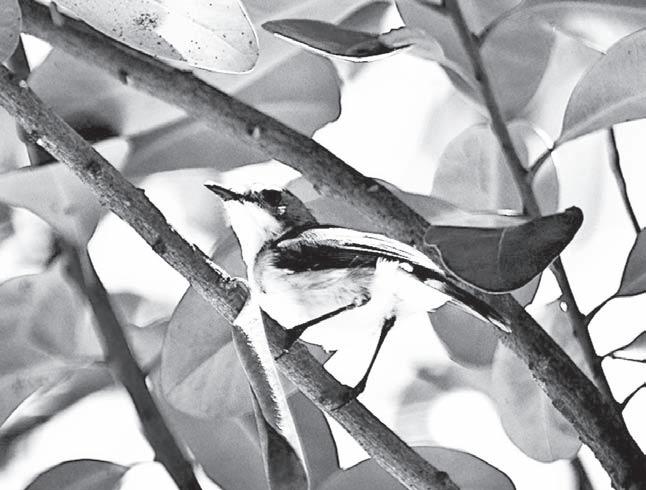
He pointed out that to truly bring back Philippine biodiversity, native and endemic plants and trees should be prioritized for all tree planting and forest restoration initiatives.
Science-based reforestation
INTERNATIONAL biodiversity expert Theresa Mundita S. Lim, meanwhile, said the study being endeavored by UP scientists is laudable as it will help improve the way we do reforestation.
“With science-based plans and policies, studies on ecology and natural regeneration in our reforestation efforts, we will have a more efficient, cost-effective and sustainable greening program,” said Lim, the executive director of the Asean
plant a narra tree under my name. used to hike mountains, so I thought this should be manageable for me despite lack of practice and preparation.
Halfway through, it felt like my heart has transferred to my ear. I could hear my own heartbeat, and my breathing started to get shorter.
The trail has yet to be fully developed at that time. Some inclines had been carved as temporary stairs, while certain portions are extra steep that would be tougher to climb during the rainy season. I can only imagine the likes of de la Cruz doing this every single day—sometimes even more than once a day.
“My inspiration is my children, my family. I don’t like them to experience what I suffered. I like them to finish their studies and have a good life,” de la Cruz shared in Filipino.
Before joining MBCC, he would do various odd jobs to make ends meet. He planted sweet potato and banana for his family’s food, until he learned about the MBCC construction.
He started doing various tasks until he was finally given the permanent job as caretaker and messenger in 2022.
To help de la Cruz and other maintenance workers earn extra money, MBCFI provided them with chickens to raise at the site and sell when fully grown. On Sundays, he would check on the chickens.
MBCFI has also given free handicraft training to some of the IPs in the community.
“I would like to buy a vehicle, even just a motorcycle. I can use it in going to the site and to the town to sell our farm produce and my wife’s handicrafts,” he said.
The daily routine doesn’t come without
Centre for Biodiversity (ACB).
Lim underscored the importance of protecting and conserving native birds as they perform very important ecosystem functions.
But how to do it is a big challenge, considering the many threats to their existence, particularly habitat loss due to human encroachment of forests, even in Protected Areas, hunting for food and trophy animals and the illicit pet trade.
Efficient tree-farmers
BIRDS that feed on wild fruits in the natural forests help in seed dispersal. They expand the forest naturally, through their droppings. Unlike humans, the birds can reach areas that are inaccessible and, therefore, help restore forests in steep and difficult slopes that have been destroyed from buffering us against natural disasters,” Lim said. Lim pointed out that studies have also shown that seeds processed in the guts of birds have higher rates of survival than those that were planted by humans. According to Lim, planting trees in urban areas and their vicinities are already proven to have public health benefits, such as helping to clean the air and relax the mind.

“For birds and for ecological benefits, which have long-term public health impacts, urban greening needs to be planned. Baseline information on the local vegetation and identifying native fruiting species that thrive in the natural areas around the cities would be useful to create biodiversity corridors that not only help birds thrive, but also restore and protect ecosystem functions for more resilient and sustainable urban development,” she said.
More importantly, Lim said allowing nature to take its course— such as for birds to do their job— would be the best way to let nature thrive.
“Native species are adapted to our local conditions, function better for resiliency, and support life cycles; and provide a food source for indigenous wildlife, as well as reduce risks of introduction of invasive species,” Lim explained.
challenges for de la Cruz. During the rainy season, rough portions of the trail would get muddy and slippery.
There was a time when he had to deal with a former area resident who refused to leave the premises. There were days when he would be sick, and dedicated as he is, he couldn’t help but be distressed about not fulfilling his duties for several days.
“It is difficult to get sick, but it is more difficult if I would not take care of myself. Because it is not just for me. This is also for the future of my family, and for the protection of our environment,” he explained.
Rewards of the job
ONE of the rewards that Jimmy finds in the course of his job is the human interaction.
Before joining MBCC, the most interaction he would get was with his fellow IPs and buyers from town. These days, he revels in
having the opportunity to engage with all types of people.
He’s excited to welcome more visitors as the site’s development progresses. This encourages him to continue with the job he likes doing.
And as simple as his dreams may be, it still all comes down to one big request to his fellow Mangyans and future visitors:
“Let us continue learning even outside the school. Let us protect the environment. It is the source of our livelihood, and will be the source of livelihood of our children,” de la Cruz said.
Development is still in progress, but I’m sure that hikers will love the easy climb and the rewarding view that the site offers once it is opened to visitors. In fact, even nonhikers will find the MBCC a refreshing change in their usual out-of-town itinerary.
A8 SundAy, OctOber 1, 2023
mirror_sports@yahoo.com.ph
Editor: Jun Lomibao
Zhang marked for Paris, Thailand wins 1st e-sports gold medal in Hangzhou
HANGZHOU, China—Chinese gymnast Zhang Boheng won the men’s all-around title Tuesday at the Asian Games, putting himself up as a name to watch at next year’s Paris Olympics.

Z hang missed out on competing at the Tokyo Olympics in 2021, but won the all-around title later in the year in Japan at the world championships. Missing Tokyo was actually a very precious learning experience for me,” Zhang said in his biography for the Asian Games.
Takeru Kitazono of Japan took silver, with bronze for Lan Xingyu of China.
The all-around medal was one of the most highprofile events on Day 3 at the Asian Games.
Other countries win medals at the Asian Games in addition to China, but it can be difficult to notice with the host country’s total dominance.
Th rough 93 gold medals awarded so far, China has claimed 49. South Korea and Japan are far behind as China’s major challengers.
HANGZHOU—If you’re looking for another kind of esport to follow from the Asian Games, try the centuries-old card game of bridge.
Here the “e” would stand for “elderly” to represent the game’s aging demographic— not for “electronic” as in the youth-driven online gaming that’s proving to be one of the most popular events of the Asian Games, generating billions in annual revenue worldwide, and producing a new breed of global icons like South Korean League of Legends star “Faker.”

Esports, chess, and bridge are among the so-called mind sports with full medal status at the two-week long Asian Games.
K elvin Ong heads the Singapore Bridge Association and laments it’s difficult to attract the nation’s youth to bridge. But as he talks he, himself, is playing a video game on a tablet.
“I’ll shut it down,” the 37-year-old says sheepishly, knowing he’s inadvertently highlighted the problem. “I think bridge is losing its following with the young because now there are computer games, mobile games.”
Kids nowadays want action to come flashy and quick—30 seconds,” Ong adds, noting a bridge hand takes seven or eight minutes to play. “We’ll get to that level when someone finds a way to made a bridge hand last one minute. But it won’t be good bridge.”
B ridge at the Asian Games is the antithesis of flashy and quick. It’s more staid and deliberate, and of course there’s no premium on physical fitness. It’s also one of many sports or games you won’t
NEW YORK—TikTok has become a key marketing channel for vendors promoting steroids and other bodybuilding drugs to millions of the app’s users, according to a report released Thursday that the social media company disputes.
I n the study, the nonprofit Center for Countering Digital Hate (CCDH) says popular videos encouraging use of the products for aesthetic or athletic gain are being posted by influencers who often downplay the risks associated with them.
find in the Olympics.
At least nine players in the field of about 200 are over 70. The oldest is 78-year-old Masood Mazhar of Pakistan, a full 65 years older than 13-year-old Chinese skateboarder
Cui Chenxi who won gold on Wednesday.
There was an 89-year-old player five years ago at the games in Indonesia, but no octogenarians this time.

You can play until you’re 100,” said 64-year-old Anal Shah, the coach and nonplaying captain of the Indian women’s team.
There’s no retirement age,” added Dr. Raheel Ahmed, a radiologist who manages the Pakistan team.
The average age of participants this time
is about 50, and the youngest are 22-year-old Vidhya Patel of India and 23-year-old Chen Kuan-hsuan of Taiwan.
C hen said she started playing at eight, coerced by her mother, an elementary school teacher.
“ She held summer vacation classes to teach students to play bridge,” Chen said.
“So I was forced by her to learn bridge. I was very unhappy because I wanted to play over summer vacation. I tried to refuse her, but she was very strong.”
The bridge venue is set up on the 12th and 13th floors of a Hangzhou office building. A nearly silent atmosphere pervades the space. Four players each fill
It follows a warning issued by the US Food and Drug Administration in April about performance-enhancing drugs being marketed to teenagers and young adults on social media platforms. They’re being marketed to young men by influencers who are deliberately saying, ‘If you want to be like Captain America, you’ve got to take these drugs,’” CCDH founder and CEO Imran Ahmed said.
The findings from the study show TikTok videos—under certain hashtags—promoting what researchers called “steroid-like drugs” have racked up more than 587 million views in the US during the past three years, with 72 percent of those views coming from users aged 18 to 24.
The report also alleges that several dozen influencers promoted websites that sold the drugs either directly or through affiliate marketing schemes that could allow them to benefit from sales.
TikTok spokesperson Ben Rathe criticized the report, saying the group’s methodology doesn’t distinguish between harmful videos and positive content that
talks about recovery from steroids or their side effects.
It’s not possible for the CCDH to know that based on the type of data they’re presenting and sheer volume of videos that are on TikTok, he said.
R esearchers said they assessed the top 20 videos under some hashtags, and all of those under other hashtags that contained fewer than 20 videos.
The information for the report came from TikTok’s publicly available Creative Center tool. Researchers were unable to measure how many times users under 18 came across such content since the company does not provide that information. Ahmed said in an interview that his group has asked TikTok to make that type of data available for assessment.

Similar to Instagram, TikTok has a large fitness community made up of users who talk about various things, including exercise and steroid use. Popular videos posted on the app speculate on who’s “natty or not,” or who’s naturally fit or taking steroids.
dozens of small tables—card-table size, of course. Many hold a fan-like spread of cards in one hand, and a few fiddle with reading glasses in the other.
Each table has a screen running diagonally—top and bottom—to keep players from passing signals to teammates. The game presents no language barriers, using universal terms from English like “no trump, slam, pass” and so forth.
O bservers can watch the hands that are dealt—and how they are played—on large television screens filled with red and black symbols for spades, hearts, diamonds and clubs.
O ng said teams playing contract bridge have been known to—not in competitions— “kick, cough and stomp” to pass signals to teammates. Hence, the screens.
In addition to the aging players, Bridge also has an image problem, at least in parts of Asia.
“ The general concept is India is that cards is gambling,” Shah said. “Bridge is cards, and cards is gambling. You have to convince parents that it’s an intellectual game. It improves your logical powers. It sharpens so many skills for the brain.”

O f course, bridge has nothing to do with poker or black jack and would be as out of place in a casino as Spain’s national festival of bullfighting might be in Bhutan.
The misconception also exists in Pakistan, a predominantly Muslim country where Dr. Ahmed said he uses a different pitch.
We don’t have any muscles in the brain, but by playing bridge you can see you can build the mind muscle,” he said.
I think 99.9 percent of our people don’t know what bridge is,” he added. “In Islam we don’t like betting so most of the people connect card games with betting. They laugh at me wearing a beard. They say he’s participating in such an event; a religious person playing a card game. Yes, I have to explain.”
THAILAND won the first medal ever awarded at the Asian Games in esports, beating Vietnam on Tuesday in Arena of Valor Asian Games Version to take bronze in the competition.
China won the gold medal, with silver for Malaysia.
Online games are swelling globally in players and revenue, and the esports competition at a purpose-built 4,500-seat stadium in Hangzhou has proved to be one of the most popular events at this year’s games.
A fter being a demonstration sport at the last games in Jakarta, Indonesia, it’s part of the medal competition for the first time this year.
The competition features five PC games and two mobile games, covering both the multiplayer online battle arena, or MOBA, and single-player genre.
The International Olympic Committee would like to be involved in esports in some way because of the revenue possibilities, but IOC president Thomas Bach has spoken out againt the violence portrayed in esports.
A rena of Valor Asian Games Version, also known as Honor of Kings, is a mobile game that pits two teams of five against each other on a simulated battlefield.
The other games in this year’s competition are: League of Legends; Peace Elite Asian Games Version (also known as PUBG Mobile); Dota 2; Dream Three Kingdoms 2; Street Fighter V: Champion Edition; and EA Sports FC (also known as FIFA Online 4).
TOKYO Olympic champion Panipak Wongpattanakit did it again in the Asian Games. She picked up gold in taekwondo at 49 kilograms on Monday, defeating Guo Qing of China. Her gold medal was Thailand’s only gold in Tokyo, and the gold in Hangzhou was the first for the country at this year’s Asian Games. Teammate Banlung Tubtimdang followed up on Tuesday with gold at 63 kilograms.
MONGOLIAN SILVER
GONCHIGSUREN BATHUYAG of Mongolia had to settle for silver in Tuesday’s 100-kilogram judo final. Mongolia has yet to win a gold in this year’s Asian Games and the best hope may come later in freestyle wrestling with Lkhagvagerel Munkhtur.
BRUNEI’S MEDAL
BRUNEI has never won a gold medal at the Asian Games, but Basma Lachkar took silver in wushu this year for the country’s best-ever result. Wushu was introduced into Brunei about 15 years ago by China.
CRICKET BIGGIES
INDIA and Pakistan are favored to reach the men’s cricket final on October 7. The powers in the tournament—India, Pakistan, Sri Lanka and Bangladesh—don’t enter play until the quarterfinal stage on October 3 and 4. Meanwhile, teams like Mongolia will be in action. Mongolia’s average cricket team age is 19.
RUGBY SEVENS
HONG KONG defeated South Korea, 14-7, to take the men’s title on Tuesday, and China edged Japan 22-21 for the women’s gold. AP
CHINA’S Zhang Boheng competes in the parallel bars during the men’s allaround individual event of the 19th Asian Games early last week. AP



Stepping beyond the bounds of convention, this band defies expectations with their unique blend of character diversity and musical excellence, weaving a spellbinding tapestry of songs, compositions, and music videos that resonate far and wide.
“Nagkaroon ng involvement sa lahat ng releases ng song and sa movement ng banda,” Froilan Bautista, SUGARCANE drummer told Soundstrip, despite their unique perspectives, everything within the group harmoniously comes together.
Adding “Lahat kami accountable and responsible sa lahat ng i-release namin.”
Carl Guerzon, the vocalist and bassist for SUGARCANE, mentioned that prior to Ronamae Tañola joining the band as a flutist, their music predominantly
leaned towards pop.
The band encountered a difficulty in figuring out how to seamlessly integrate the flute into their overall sound.
Nevertheless, as they confronted these musical disparities and worked together as a group, they experienced growth and pushed their boundaries, ultimately igniting a sense of maturity within themselves.
Since the band started they have undergone significant transformation in their musical knowledge and stage performance. Their musical journey began with cover songs but has since shifted towards creating their original compositions.
Reflecting on their progress, Froilan expressed
amazement at how far they’ve come from their humble beginnings, “Nalaman namin na kaya pala namin ‘yun.”
SUGARCANE proudly shared with Soundstrip that their most notable evolution has been their ability to reconcile their differences, not only as a band but as individuals as well.
The band’s drummer added, “ Nakuha namin tanggapin ang differences namin,” highlighting the importance of accepting and leveraging their unique qualities for their collective success.
“We learned how to communicate with one another at sa ibang tao Lalo na sa mga nakakatrabaho namin,” Luis Beato, SUGARCANE's keyboardist shared.
With the exposure in the music industry, they were able to build more confidence within themselves.
THE talented group has amassed a substantial following with a collection of music covers and an impressive eight original singles, several of which have already garnered millions of streams.

Notably, ‘Leonora’ currently leads the pack with over 20 million streams, a testament to their knack for creating music that deeply resonates with their audience.
Frain Reyes, the band’s lead guitarist, shed light on the potential factors behind the recognition of“Leonora” and “Kung Maging Akin Ka,” both of which found their way into Spotify’s Viral Hits Philippines list in April this year; the story behind it and how the song was arranged, as he believes that it is totally different from the band’s previous releases.
He likened their music to a vintage cinematic experience from the 1950s, yet it manages to captivate today’s generation.
With a retro twist and a modern groove, SUGARCANE’s music finds its way to the top and earns coveted award nominations.
In the Awit Awards 2022, they were nominated for Favorite Group Artists, and their song ‘Paruparo’ is in the running for Song of the Year, Best Alternative Recording, and Best Collaboration in the Awit Awards 2023.
“Binibigyan namin kasi ng kwento ang kanta and iba’t ibang application niya,” Carl emphasized their commitment to presenting multiple interpretations that the audience can derive from their musical releases.

Publisher :
Editor-In-Chief :
Concept :
Y2Z Editor :
SoundStrip Editor :
Group Creative Director :
Graphic Designers :
Contributing Writers :
T. Anthony C. Cabangon
Lourdes M. Fernandez
Aldwin M. Tolosa
Jt Nisay
Edwin P. Sallan
Eduardo A. Davad
Niggel Figueroa
Anabelle O. Flores
Tony M. Maghirang
Rick Olivares
Patrick Miguel
Jill Tan Radovan
Reine Juvierre Alberto
John Eiron R. Francisco
Pocholo Concepcion
Francine Y. Medina
Y2Z & SOUNDSTRIP are published and distributed free every Sunday by the Philippine Business Daily Mirror Publishing Inc. as a project of the

The Philippine Business Mirror Publishing, Inc., with offices on the 3rd Floor of Dominga Building III 2113 Chino Roces Avenue corner Dela Rosa Street, Makati City, Philippines.
Tel. Nos. (Editorial) 817-9467; 813-0725.
Fax line: 813-7025
Advertising Sales: 893-2019; 817-1351,817-2807.
BUT the band isn’t resting on their laurels. They’ve recently dropped their latest track, “Sinehan,” - about two lovers on the verge of a breakup, realizing that they
are not meant for each other.
Carl opened up to Soundstrip about the inspiration behind“Sinehan,”describing it as a cinematic experience. He explained, “It tells stories that are like they’re being presented on the big screen of our lives,” hinting at a bittersweet ending.
Carl told Soundstrip about the inspiration behind “Sinehan,” describing “it refers to a cinematic experience.”
As Luis personally described the impact of their latest track as the “art of letting go.” He sees it as akin to experiencing a breakthrough that you’ve long sought but couldn’t achieve.
“It’s like trying to get out of something, trying to get out of a hole,” Luis said.
With lyrics like“pumipiglas ang ating puso, patungo sa isang panibagong yugto” paired with emotioncharged vocals, Sugarcane’s latest track is bound to capture the hearts of their fans.
It’s the perfect anthem for those who are going through the process of accepting that love can fade, and those who are trying to move on from a failed relationship.
The creation of“Sinehan”was a collaborative effort involving Carl, Cedric Angeles (vocalist and guitarist) and Froilan. Interestingly, it began as two separate songs, with Cedric contributing the chorus parts from a song he struggled to complete, while Carl provided verses for an unfinished composition.
Eventually, they decided to merge these two songs, with Froilan crafting the bridge that brought “Sinehan” to life.
“Basically, parang siyang pinagsama-samang songs, into one,” Froilan highlighted.
The “Sinehan” music video features Francine Diaz, an actress who happens to be a fan of Sugarcane’s music. She shared the band’s song “Leonora” on her social media, which coincided with their decision to contact her.
“We’ve always dreamt of having Francine as the lead in one of our MVs. When we got the opportunity to have her star in the MV of ‘Sinehan,’her professionalism really exceeded our expectations. It was definitely a great experience working with such a talented and down-to-earth actress. We’re grateful she agreed to be part of our MV,” Froilan shared.
Following the launch of “Sinehan,” SUGARCANE is gearing up for Warner’s 30th Anniversary, and the band has given a glimpse of their plans, expressing their hope to unveil another track later this year.
Photographers :
Bernard P. Testa
Nonie Reyes
Circulation: 893-1662; 814-0134 to 36. www.businessmirror.com.ph
THE term “opposites attract” isn’t just a cliche, but a creative force to be reckoned with, from the clash of personalities and musical talents, SUGARCANE proves it.SUGARCANE
“Ngumiti kahit na napipilitan
Kahit pa sinasadya
Mo akong masaktan
paminsan-minsan
Bawat sandali na lang…”
WHO could ever forget this iconic Original Pilipino Music (OPM) classic from the 2000s that remains heartbreaking up to this day?
When I heard the band Join the Club perform their hit song live at the recent One Stop Record Fair, I stood there feeling nostalgic for a reason, and I’m sure everyone in the crowd felt the same way.

Hearing “Nobela” again after a few years evokes different emotions and memories as if it has the ability to bring its listener back to the good, old days.
The song’s lyrics personify poetry itself, and lead vocalist Biboy Renia wrote it masterfully and thoughtfully, gaining full control of the richness of the Filipino language even as this alternative rock song’s heart-wrecking melody and guitar solo will rouse a person further into despair. You’re not really heartbroken but it made you feel like it.
The band also played their hits ‘Bagong Panimula,” “Lunes,” “Dekada,” and a cover of Eraserheads’s “Pare Ko” to the audience, and it’s OPM rock at its finest.
Join the Club is a Filipino alternative rock band formed in 2001, back when they were students in the Conservatory of Music at the University of Santo Tomas. Two decades later, the group is as tightknit as ever and still has more music to write and perform.
Twenty years strong
IN an interview with SoundStrip, Renia shared that their respect for each other is what kept them intact and stayed this long in the industry. Recalling their times spent in college, he said that they dealt with each other’s “topak” (tantrums) and mood swings before they formed the band.
“Malaking tulong yung foundation na lumaki kaming magkakasama nung college kami,” he added. [It was a big help that our foundation was growing up together during college.]
Lead guitarist Migs Mendoza also looked back on their college days when they used to live with each other in a dormitory near their university, which he said strengthened their relationship as brothers.
“Kasi kapag magkakasama kayo sa isang apartment, magkakapatid kayo,” he beamed. [When you live together in an apartment, you’re like siblings.]
But during those 20 years spent together as a band, bassist Congie Lulu found it challenging to maintain the tightness of their group but stressed
the importance of having passion.
“Syempre nandoon pa rin kailangan yung passion mo sa ginawa mo. Tuloy pa rin para ‘di magkaraoon ng ‘di pagkakaunawaan saka maging successful pa lalo,” he imparted. [Of course, you need to have passion in what you do. It should be continued so there won’t be any conflicts and to be more successful.]
From being the college students handing out flyers around the university belt to come to their gigs to announcing their shows within the country on their social media accounts, Join the Club stood the test of time.
These titos’ passion, true enough, has come a long way and they’re still proving that they are ‘OPM rock veterans.’
AS the band matures, so does their take on love as reflected through their current songs. With the usual “hugot” songs about heartaches on pause, they are embracing a “positive take on love and appreciation” but with their trademark poetic lyrics filled with emotions and their nostalgic and distinct sound.
Recently, the band released a single titled “Going Home ‘82,” which is about going home—to be back to that person you love. Fans should anticipate the band’s upcoming Christmas EP, following their single “Every Yakap Mo Pasko” released last year.
When SoundStrip asked, “Why a Christmas EP?” Renia answered that for 20 years, it’s already long overdue for them to release it.
“Gusto namin sa mga susunod na panahon, decades from now, meron kaming something to look back na gumawa pala kami ng Christmas songs,” Renia mused and that every year they would hear it, it’s something that they would celebrate. [We want for the coming years, decades from now, we have something to look back on, that we created Christmas songs.]
Although it’s a joy to ring bells to the songs, the band said “it’s a bit of a challenge.”
“Di siya yung compared sa normal songs, kapag Christmas [songs] mahirap,” drummer Mark
Garchitorena added. [It’s not like compared to normal songs, when it comes to Christmas [songs] it’s difficult.]
“Parang ang dali gumawa ng Christmas song, pero mahirap gumawa ng magandang Christmas song,” Renia seconded. [It’s looks easy to create a Christmas song, but it’s difficult to create a good Christmas song.]
Since the start of September, the Christmas spirit can already be felt because Filipinos love celebrating the holiday. “Parang legacy for us na kapag naging successful yung paggawa namin ng Christmas EP, it would be like para sa ating mga Pinoy,” stated Lulu. [It would be a legacy for us that when our Christmas EP becomes successful, it would be for us Filipinos.]
Apart from this upcoming EP, fans can also look forward to their next full-length album next year, and to those who still collect physical copies, they will be releasing limited CDs as well.
Despite the changes such as the ease of releasing new music through singles and digital formats, the band is kicking it old school. They also have plans on re-releasing their older albums like Nobela and Gera ng Balarila on vinyl records.
Why vinyl? It’s because they grew up listening to their musical heroes like Eraserheads and The Beatles through physical formats and collecting them as well, Renia said.
“Lumaki kami ng analog [era] eh, so ako talaga, yung sense of possesion gusto ko talaga,” Renia shared. [We grew up in the analog [era], so for me, I like having a sense of possession.]
Renia also revealed that they started the band not because of money or fame, but to create music that they will enjoy and at the same time, quality music to contribute to the arts.
Join the Club is arguably one of the best OPM bands of the new millennium. With their genuine passion for music, exceptional songwriting, and musical talent, and with their songs resonating until now—masterpieces, their legacy is pretty much secure. Their own personal “nobela,” however, is far from over.
 By Kyoungjin Jang-Tucci, Hee Song, & Matthew T. Hora University of Wisconsin-Madison
By Kyoungjin Jang-Tucci, Hee Song, & Matthew T. Hora University of Wisconsin-Madison
WHEn Angelica landed a prestigious internship with a major corporation just outside of Houston, she was ecstatic about the opportunity to launch her career in finance.
Such optimism was warranted, as research shows that students with internships are almost twice as likely to graduate college, have a 12.6 percent higher likelihood of being invited to job interviews, and earn 6 percent higher wages than non-interns once they graduate.
But even with a decent paycheck and scholarships to cover her rent, a n gelica considered leaving the internship within weeks. What went wrong? a s part of the three-year College i nternship Study at the Center for Research on CollegeWorkforce tr ansitions at the University of Wisconsin-Madison, we found that interns can have a tough time adapting to the culture of a new city, organization and work environment.
i n a n gelica’s case, she knew of only one other Hispanic woman in her intern group, and the company itself, she said, was mostly white. Ultimately, she believed that “none of these people really have anything in common with me.” She felt excluded and started to believe it would be impossible to work full time at the company.
a n gelica’s story demonstrates that not all student interns have positive and productive experiences. i n f act, research shows that internships can reinforce gender inequalities in the workplace, create unrealistic expectations for career advancement and even exploit stu
dent labor.
Common internship pitfalls
tH e e ducational aspect of internships frequently gets overshadowed, with interns assigned mundane or repetitive tasks unrelated to their academic or professional interests. This can hinder their career development by diminishing their motivation to pursue a career in that field.
a nother problem, which our own research revealed, is that too often supervisors adopt a hands-off strategy. They expect interns to define and complete tasks independently. While this may work for long-term or mature employees, it is unsuitable for most interns who are new to professional life. The lack of structure and guidance can cause significant stress that weakens their learning and job performance.
We offer four strategies for designing effective and welcoming internships for college students, based on our research.
1. Set clear learning goals
l e a R n inG goals can include specific tasks the intern will be expected to perform, technical knowledge they will gain and transferable skills like communication or teamwork that they should develop through the internship.
ideally, they are developed in collaboration with faculty advisers, students and employers. We especially emphasize the importance of engaging students in these conversations. Different interns will like -
ly have unique objectives for their own internship experience.
2. Structure assignments from easy to hard
a W ell-K nOW n theory in educational psychology shows that people learn best when they are gradually introduced to new tasks or subject matters. i n our own study, we found that interns also benefit from starting their jobs with easier tasks and gradually transitioning to tasks that require less oversight.
3. Keep communication open
Re Se a RC H confirms the importance of clear, regular and open lines of communication between interns and their supervisors. This became especially important during the height of the Covid-19 pandemic, when online internships suffered from infrequent and virtual communications. Many interns were left feeling unsatisfied and neglected.
4. Connect interns with appropriate mentors
eM pl Oyee S i n general benefit profes -
“The educational aspect of internships frequently gets overshadowed, with interns assigned mundane or repetitive tasks unrelated to their academic or professional interests.”
io on Pexels.com
sionally and psychologically from having workplace mentors with similar backgrounds and identities to their own. ye t, workers from marginalized groups—especially women—often have a harder time finding supportive and relatable mentors. Companies can survey interns on their values and preferences regarding mentoring and supervision, and then match them in accordance with their mentorship needs and preferences. a d ditional strategies to enhance interns’ sense of belonging include peer mentoring and frequent social events—methods that have been proven to help newcomers adapt to new environments.
We believe internships must be seen as more than a part-time job where students simply need to be hired, onboarded and shown a desk. i nternships are learning opportunities and, as such, require careful design. Done right, internships can help interns gradually get more acquainted with the culture where they work and the jobs they will be expected to do. The Conversation
Capital One ph ilippines reiterates its strong commitment to the future of the next generation. By advocating transformative education, the a merican bank holding company specializing in credit cards seeks to address the demand-supply challenges within the local it and Business p rocess Management ( i t-BpM ).

a ccording to a study by Global management consulting firm Kearney, the i t- BpM i ndustry is experiencing a “talent demand-supply gap.” The disparity might grow up to 400,000 in five years if left unchecked.
Through its community education initiative, Contact Center Readiness p rogram (CCR p), Capital One ph ilippines teaches students basic proficiency and other capabilities needed for entry-level
positions in the it- BpM i ndustry. The program runs for nine months in partnership with tu loy Foundation.
“The ph ilippines is a hub for customer experience due to its strong foundation that translates well in our industry,”

said J p paperman, Capital One ph ilippines Head of Operations. “ i ncorporating technology with the heart will put us in a place where there is no other footprint in the world that will compete with our workforce regarding future readiness.”
Meanwhile, Kaneth Santiago, Capital One ph ilippines Director for Strategy and Community, believes it is important to make entry to the it- BpM i ndustry easier for new hires by incorporating soft skills in the current curriculum. What is needed, she said, is education transformation, which does not require a complete overhaul.
“ i ntegrating skills required in the workplace with the current education system is key,” she added. “The focus should be on developing communication, business, and financial skills along with
soft skills like persuasion, and de-escalation. p roviding access to these skills will enable the youth to succeed in their workplace quickly.”
The CCR p is one of the flagship social investment programs of Capital One ph ilippines. paperman believes it can help bridge the talent demand-supply gap in the it- BpM i ndustry.
“Through the CCR p, we offer opportunities to highly motivated and talented individuals who require a unique form of investment early on to help them unlock their potential,” he said. “By doing so, we gain access to gifted individuals, which, in turn, becomes a return of investment.
CCR p is an excellent example of how this concept of ‘train and retain’ works, as it has helped us discover some genuinely exceptional gems of talent.”